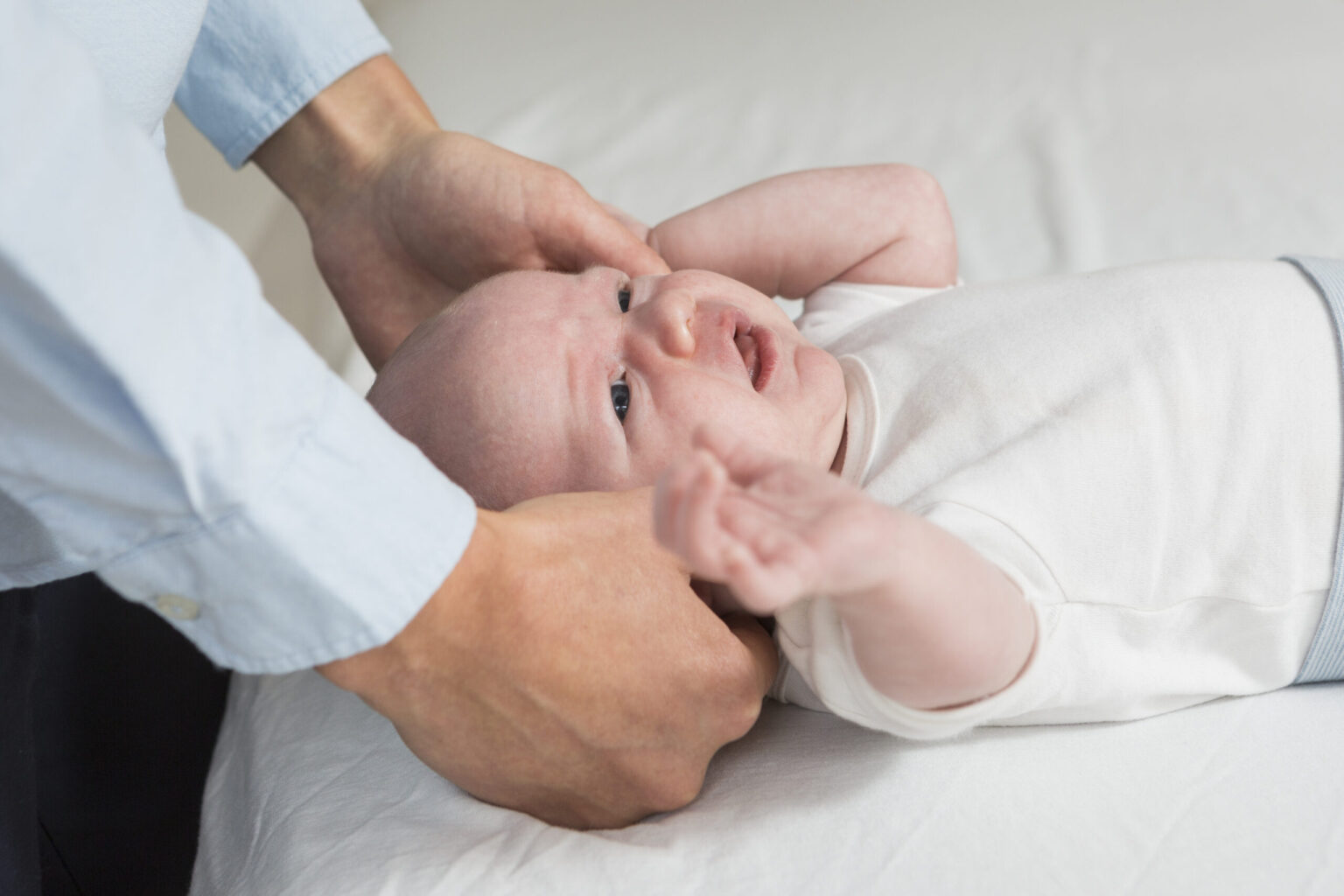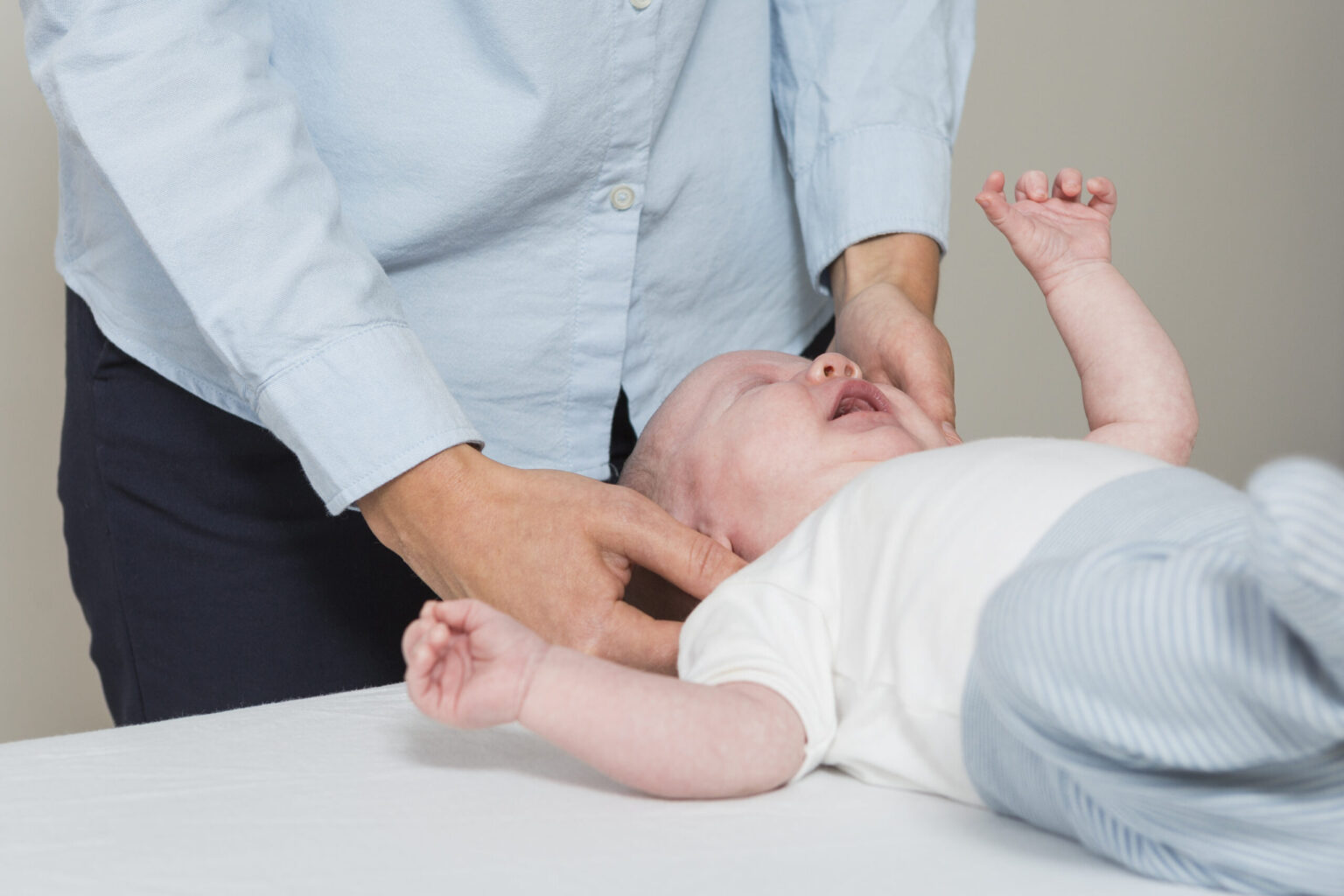We offer gentle osteopathic support for
Colic-Like Behaviour in Babies
Learn more about colic-like behaviour in infants and gentle ways to support your baby
What is colic-like crying in babies?
The term colic is often used to describe episodes of intense crying or fussiness in an otherwise healthy baby under 5 months old. A common description is crying for more than three hours a day, on more than three days a week, for at least three weeks – sometimes referred to as the “rule of threes.”
This definition simply helps describe a pattern of prolonged crying. It does not point to a specific cause, and many babies experience periods of unsettled or intense crying during their development.
Jump to section [Show]
Signs parents may notice with colic-like behaviour
Babies who show colic-like crying patterns may also display:
- Intense crying or fussiness, often more noticeable in the late afternoon or evening
- A tummy that feels firm or looks rounded
- More frequent gas or burping
- Increased spit-up
- Restless or short sleep periods
- Appearing more unsettled or difficult to soothe
These behaviours can occur for many different reasons and often change as the baby grows and develops.

What is “3-month colic” in babies?
Many parents notice that periods of intense crying often begin when a baby is around two weeks old, become more frequent around six weeks, and then gradually reduce again as the baby approaches three to four months. For this reason, the term “3-month colic” is sometimes used to describe this developmental phase.
A doctor is the person who assesses whether a baby’s crying pattern fits the description of colic. In most cases, babies with prolonged crying have normal examinations and tests, and no specific medical cause is identified. These crying phases usually resolve naturally as the baby grows.
Why do babies cry?
Crying is a baby’s primary way of communicating. It is completely normal and can reflect a wide range of needs, from feeding, tiredness and overstimulation to simply seeking closeness or expressing discomfort.
Some babies may cry more during particular developmental stages or when adjusting to new sensory input. Periods of fussiness can also relate to digestion, tiredness, tension or the baby’s emotional state. Most of these phases are temporary and change as the baby matures.
How much crying is normal for a baby?
It is completely normal for a healthy baby to cry for around two hours a day on average. Crying often increases in the late afternoon and evening, which may relate to tiredness, hunger, overstimulation or simply processing the day’s experiences.
When crying feels intense or difficult to soothe
Sometimes babies cry in a way that can feel more intense, prolonged or difficult to settle. If feeding, sleep, overstimulation and nappy changes have been ruled out, parents may wonder whether their baby is feeling discomfort or tension somewhere in the body.
In such situations, it can be helpful to speak with a healthcare professional, such as a GP, health visitor or paediatric specialist. Some families also choose to consult an osteopath, who can gently assess the baby’s overall comfort, movement and tension patterns in a calm and supportive way.
Crying in the late afternoon
Many babies become more unsettled in the late afternoon and early evening. This may relate to a mix of factors such as:
- tiredness after a full day
- hunger clustering
- overstimulation
- difficulty winding down
- general fussiness common in the early months
Some babies may also have shorter or more fragmented sleep during periods of increased evening fussiness.
Parents often notice a difference between “I-need-something” crying and crying that feels more intense or ongoing. The latter may sound higher-pitched or be harder to soothe, and can understandably feel overwhelming.
If parents are concerned about how much or how intensely their baby is crying, seeking guidance from a healthcare professional can offer reassurance and support.

What can contribute to colic-like crying?
Periods of intense crying can be very challenging for parents, and it’s natural to want to understand why it happens. It’s important to remember that prolonged crying does not mean something is medically wrong – many babies go through phases where they are harder to settle.
There is no single known cause of colic-like crying, but several factors may contribute, including:
- Hunger or cluster feeding
- Tiredness, overtiredness or difficulty settling to sleep
- Overstimulation after a busy day
- General discomfort
- Difficulty winding, burping or passing gas
- Sensitivity during digestion
- Reactions to certain foods in the breastfeeding parent’s diet (in some cases)
These factors vary greatly between babies, and crying patterns often change naturally as the baby matures and their digestive and nervous systems develop.
Is baby colic hereditary?
There is no clear evidence that colic-like crying is hereditary. Current research suggests that prolonged crying is likely influenced by many different factors rather than a single cause, and these factors can vary greatly from baby to baby.
What can parents do during colic-like crying phases?
As new parents, periods of intense crying can feel overwhelming. It may help to remember that crying is a baby’s way of communicating, and it does not necessarily mean something is seriously wrong.
You can begin by following the guidance of your GP or health visitor. This may include:
- Checking feeding positions
- Ensuring the baby is well-burped
- If breastfeeding, ensuring the baby is comfortable and able to feed effectively
- Reviewing feeding patterns with a professional if you have concerns
Many babies pass through these phases naturally as their digestive and nervous systems mature.

How to soothe a crying baby
Because colic-like crying can have many contributing factors, there is no single approach that works for every baby. However, many parents find that small adjustments and comforting routines can help soothe their baby during unsettled periods.
Here are some gentle ideas parents often try:
- Pause for frequent burping during feeds
- Allow the baby to feed until satisfied
- Avoid switching breasts too quickly when breastfeeding, so the baby can access the milk that comes later in the feed
- Check that the feeding or breastfeeding position feels comfortable for both baby and parent
- If you have concerns about feeding or digestion, speak with your GP, midwife or health visitor before making changes, including adjusting your own or your baby’s diet
Some parents also notice that certain sounds or movements help calm their baby, such as:
- White noise (e.g. a fan, washing machine, gentle humming sounds)
- Gentle rocking or motion
- A warm bath or skin-to-skin contact
Every baby is different, and it may take time to learn what soothes your child best.
Osteopathy and colic-like behaviour
Birth is a significant physical experience for a baby, and it is common for them to show temporary areas of tension or tightness afterwards. This can be influenced by many factors, including how the baby was positioned during pregnancy and the way the birth unfolded. Assisted births, such as those involving suction or forceps, may also create different pressure patterns on the baby’s head, neck or body.
These pressure changes can sometimes influence how comfortably tissues and muscles around the neck, jaw and upper body move. The cranial area contains several important structures, including the pathways of the vagus, glossopharyngeal and accessory nerves, which play roles in swallowing, coordination of muscles around the neck and general regulation within the body. When tissues in this area feel tight, some babies may appear more unsettled or have difficulty relaxing.
Osteopaths take a whole-body approach when assessing babies. During a consultation, your osteopath gently explores your baby’s comfort, movement and tension patterns and looks at how different areas of the body relate to one another. The goal is always to support relaxation and ease of movement, and to offer parents practical guidance for soothing, positioning and everyday handling.
If an osteopath notices signs that other factors may be contributing, for example, issues related to feeding, ear discomfort or tongue function, they can advise you to seek further guidance from your GP, midwife or other appropriate professionals.

Osteopathy and colic-like behaviour
Osteopathy is a gentle, hands-on approach that considers how different parts of the body work together. When osteopaths see babies, the session begins with a conversation with the parents about their observations, followed by a calm, full-body assessment. This helps the osteopath understand the baby’s overall comfort, movement and areas that may feel tight or sensitive.
During the session, the osteopath uses only their hands and very soft techniques adapted to infants. They look at how different structures relate to one another – for example, how tension in one area may influence ease of movement elsewhere. The aim is always to support relaxation, comfort and a sense of ease in the baby’s body.
Osteopaths can also explain their observations to parents, helping them understand possible movement patterns or areas where the baby may benefit from gentle support during everyday care.
A check-up for reassurance
The exact cause of prolonged crying in young babies isn’t fully understood, and there is no guaranteed way to prevent it. However, many parents find it reassuring to have their baby checked by an experienced practitioner if they are concerned about tension, posture or comfort.
An osteopathic check-up can provide:
- A clearer picture of the baby’s overall comfort and movement
- Reassurance for parents who sense something feels “off”
- Practical guidance on soothing, handling and positioning
- Support when navigating unsettled phases
If the osteopath notices anything that may require further assessment – for example, feeding challenges or possible medical concerns, they will recommend contacting your GP, midwife or health visitor.
Osteopathy and colic-like crying
While osteopathy does not treat colic as a medical condition, many families choose osteopathic support during phases of prolonged crying because the sessions focus on relaxation, comfort and gentle movement. Osteopaths have extensive experience working with babies, and their calm, hands-on approach can be a supportive part of a family’s wider toolkit during this challenging period.
Gentle ideas and guidance for babies during colic-like phases
Because colic-like crying can have many different contributing factors, it’s not always possible to recommend specific exercises without first understanding the individual baby’s needs. During a consultation, an osteopath can offer tailored suggestions based on your baby’s comfort, movement and behaviour.
After the session, parents are often shown simple, gentle activities they can try at home to support relaxation and ease of movement.
Here are some general ideas many parents find helpful:
- Gentle leg movements through play, such as slow “bicycle” motions
- Soft, circular tummy strokes in a clockwise direction
- Pausing for frequent burping during or after feeds
- Reviewing feeding positions to ensure both baby and parent feel comfortable
- Calming touch, such as gentle whole-body stroking or rhythmic hand pressure
- Soothing routines, like white noise, rocking or skin-to-skin contact
If you are unsure or would like personalised guidance, you may choose to have your baby seen by an osteopath experienced in supporting infants. A check-up can help you understand your baby’s movement patterns and provide reassurance and practical advice for everyday care.

Often related treatments

Hypermobility in babies and children

Muscle tension or imbalances in babies and children

Torticollis

Colic-Like Behaviour in Babies

Tongue-Tie and Feeding Challenges in Babies

Baby treatment

Scoliosis

